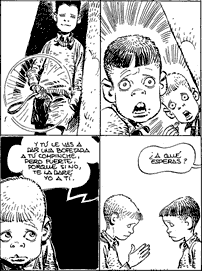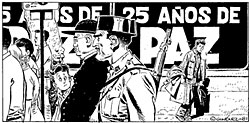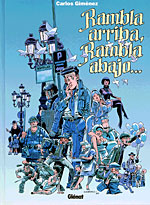>> Beyond Borders: Mondo Loco
>> Beyond Borders: Every Picture Tells A Story
More...

An old man rambles about his fate in the crowded streets of Barcelona. Life hasn't treated him well. Penniless and hungry, he tries to overcome his pride and begs for alms. He's worked all his life, but he can't do it anymore; he is condemned to live at the mercy of other people's charity. He asks for a coin, and when he receives his first, he starts crying, his pride now as broken as his life.
It's a chilling panel. It speaks to the reader with a distinctive voice. It's not a cold, third person view from a middle aged, balding, fat writer with money in the bank and fake street cred. It's the voice of man born in hunger and bred in sorrow, bleeding his life into each and every panel. Teaching you how it was, how it will be, how it is, both back then and right now. Carlos Giménez can speak about hunger and poverty because he was hungry and poor. And now he writes comics about it.
Carlos Giménez was born in Madrid in 1941, two years after the end of the bloody Spanish Civil War. Back then, the country was still in turmoil. Small guerrillas called maquis tried to destabilise General Francisco Franco's new fascist government from their bases in the south of France. Meanwhile, the Spanish government purged every sign of leftist ideology in society, jailing or killing dissidents and establishing a stern regime mixing fascism with Catholicism. All media was subject to censorship, and schools and universities were controlled by the State and the Church in an effort to "educate" the people of Spain in the building of a country, One, Big and Free under God's name, as the regime's motto stated.
 Giménez was the last child of a family recently moved from the small city of Ávila to Madrid, the nation's capital. His father died when he was one year old, and his mother, sick with a lung disease, found herself unable to raise their children, so she had to place them at the hands of a Spanish government agency, the Auxilio Social, which took care of orphans and children whose parents couldn't feed them.
Giménez was the last child of a family recently moved from the small city of Ávila to Madrid, the nation's capital. His father died when he was one year old, and his mother, sick with a lung disease, found herself unable to raise their children, so she had to place them at the hands of a Spanish government agency, the Auxilio Social, which took care of orphans and children whose parents couldn't feed them.
Separated from his brothers, Carlos was sent to Paracuellos, a horrible place where children were "educated" in the kind and loving ways of national-Catholicism, the faith of Franco's regime. Giménez spent many years there as a victim of hunger and violence; it was a nightmarish place where the teachers embezzled the children's food money, and the priests would beat the children at the slightest provocation. But the children still managed to find ways to play and let their imaginations run free.
It was in Paracuellos that Giménez began his lifelong relationship with comics, reading the adventures of Iranzo's pirate classic EL CACHORRO, drawing his own comic books and dreaming of one day becoming an artist for the series. When he was old enough to leave the children's home, he returned to live with his mother, but she died soon after, leaving him to fend for himself. He worked in a number of different jobs until he secured a position as an assistant to artist López Blanco. From there on, he would dedicate his life to comics.
 Giménez worked on daily strips for newspapers, as well as in illustration and design, before finally publishing his first comic works; but it was with his series GRINGO, published in more than twenty different languages, that his name first became widely known. As a result, he decided to move to Barcelona, where he hoped he could make his living as a comics artist and become part of the city's blossoming comics scene, which included such names as Esteban Maroto and Alfonso Font. However, though he found great success with the comic DANI FUTURO, his publisher sold the rights to Belgium's TINTIN MAGAZINE without his consent, so he opted to leave his creation in the hands of legendary Spanish writer Victor Mora.
Giménez worked on daily strips for newspapers, as well as in illustration and design, before finally publishing his first comic works; but it was with his series GRINGO, published in more than twenty different languages, that his name first became widely known. As a result, he decided to move to Barcelona, where he hoped he could make his living as a comics artist and become part of the city's blossoming comics scene, which included such names as Esteban Maroto and Alfonso Font. However, though he found great success with the comic DANI FUTURO, his publisher sold the rights to Belgium's TINTIN MAGAZINE without his consent, so he opted to leave his creation in the hands of legendary Spanish writer Victor Mora.
This occurred at a time when Spain was once again in turmoil. A dying Franco had loosened his steel grip on power, and the leftist intelligentsia was chipping away at his regime from the foundries, the universities and the arts world. A resolute Giménez decided to switch his focus from Westerns and science fiction to political satire. He started work at El Papus, a satirical magazine created to take advantage of waning censorship laws, but the magazine was later taken out of business by a bomb planted by extreme right wing terrorists. Giménez's work for El Papus with the writer Ivá was later collected in ESPAÑA, UNA GRANDE Y LIBRE - 'Spain, One, Big And Free'.
When Franco died, Spain could at last make the transition to modern democracy, and Giménez was able to switch his attention towards more autobiographical comics. He began a series entitled PARACUELLOS, which so far stands at five volumes, and narrates episodes of his life at the Auxilio Social institution in the '50s. He also started work on LOS PROFESIONALES ('The Professionals'), a humorous memoir of his years as a young artist trying to break in to the world of comics.
 In the mid '80s, Giménez became renowned as one of Spain's greatest comics creators. He followed up the three volumes of LOS PROFESIONALES with an epilogue, RAMBLA ARRIBA, RAMBLA ABAJO, a fast-paced story composed of one- and two-page episodes set on the streets of Las Ramblas in Barcelona, one of those Mediterranean avenues where lives crisscross and almost anything can happen.
In the mid '80s, Giménez became renowned as one of Spain's greatest comics creators. He followed up the three volumes of LOS PROFESIONALES with an epilogue, RAMBLA ARRIBA, RAMBLA ABAJO, a fast-paced story composed of one- and two-page episodes set on the streets of Las Ramblas in Barcelona, one of those Mediterranean avenues where lives crisscross and almost anything can happen.
While LOS PROFESIONALES is an insanely funny work, and PARACUELLOS is both striking and harrowing, RAMBLA ARRIBA could be considered Giménez's finest work. In 75 black and white pages, Giménez takes the subject of a simple evening out for himself and his colleagues at the studio and uses it as an opportunity to criticise Spain's political panorama in the late 70s and tell short, concise stories about human life.
The magic is in how he blends these stories with the main plot. It's as if we're walking with the characters, watching what they see, feeling every inch of the city and submerging ourselves in tiny episodes of the passers-by's lives with their everyday dramas and comedies.
The artwork is also superb. Gimenez's unique blend of realistic and cartoon styles matches perfectly with the story. He exaggerates the character's expressions to enhance the comedic or dramatic elements of the plot while keeping a realistic approach in his rendering. The mix works perfectly with the storyline's tone and Giménez's clean, detailed lines and masterful storytelling.
Sadly - and disgracefully - none of Giménez's works are currently available in English. While widely recognised as Spain's finest creator, and well represented in other European markets (French publisher Glénat has published some particularly beautiful editions) he remains largely unknown to the English-speaking comics audience.

This article is Ideological Freeware. The author grants permission for its reproduction and redistribution by private individuals on condition that the author and source of the article are clearly shown, no charge is made, and the whole article is reproduced intact, including this notice.


